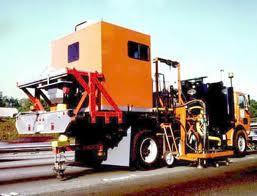Infrastructure protectionAutomated pavement crack detection and sealing system to extend roadways life
Researchers from the Georgia Tech Research Institute developed a prototype automated pavement crack detection and sealing system; in road tests, the system was able to detect cracks smaller than one-eighth-inch wide and efficiently fill cracks from a vehicle moving at a speed of three miles per hour

Automated crack detection and sealing machine in testing // Source: ucdavis.edu
Sealing cracks in roadways ensures a road’s structural integrity and extends the time between major repaving projects, but conventional manual crack sealing operations expose workers to dangerous traffic and cover a limited amount of roadway each day.
A Georgia Tech Research Institute release reports that to address these challenges, the Georgia Tech Research Institute (GTRI) developed a prototype automated pavement crack detection and sealing system with funding from the Georgia Department of Transportation. In road tests, the system was able to detect cracks smaller than one-eighth-inch wide and efficiently fill cracks from a vehicle moving at a speed of three miles per hour.
“Our prototype system has proved in many ways that a commercial-scale automated crack sealing system is viable,” said Jonathan Holmes, the GTRI research engineer currently leading the project, which began in 2003. “We demonstrated solutions to technical challenges — including the high-speed firing of nozzles, automated crack detection and navigation — in a real-time, limited-scale system.”
An automated crack sealing system would increase the level of safety for the workers involved, require fewer personnel and increase the amount of roadway covered per day. In addition, the system could save transportation departments money because sealing cracks extends the time before a roadway needs to be completely repaved.
The prototype system, which was mounted on a trailer, consists of a stereo camera, light-emitting diodes (LEDs) of two different colors, and an assembly to provide a continuous supply of sealant to longitudinal and transverse sealant distribution systems. The operation required only one worker to drive the vehicle pulling the trailer.
As the system traveled along a road lane, the LEDs illuminated the road in two directions — parallel and perpendicular to the road — and the stereo camera took two pictures of the road simultaneously, which were analyzed using thresholding and filtering algorithms. Within 100 milliseconds of taking the images, the computer onboard the trailer generated a “crack map” specifying the location and shape of any cracks shown in the images.
Based on the cracks found in the image, the master controller instructed the sealant applicator valves when to fire. To fill longitudinal cracks, a single dispensing nozzle capable of continuous operation was attached to a linear servo axis. The transverse sealant distribution system consisted of twelve nozzles spaced evenly across one foot. The transverse and diagonal distribution prototype was intended to represent one module that could be replicated and joined together to service a full-width roadway lane.
In multiple road tests, the prototype system proved to be a successful proof-of-concept for the automation of crack sealing operations.
The release notes that before a full-scale system can be successfully implemented by transportation departments, several issues must be addressed, according to Holmes. First, the crack detection algorithm will need to be improved. The researchers tested their crack detection algorithm on more than 100,000 images they collected of cracks on state roads and found the program correctly identified more than 83 percent of the cracks.
“Our crack detection algorithm was limited because we used a vision-based system, which was confounded by regions of high contrast caused by features other than pavement cracks, including dark stains in the pavement, lane stripes, raised-pavement markers, crack sealant and debris,” said Holmes. “A full-scale system may require a fusion of multiple imaging sensors, such as a 3-D laser scanning system.”
Holmes also suggested changes will be necessary in the way the sealant was supplied to the longitudinal and transverse distribution systems before a full-scale system can be realized.
David Jared, acting chief of research & development at the Georgia Department of Transportation Office of Materials and Research, and GTRI principal research engineers Wayne Daley and Wiley Holcombe, research scientist Colin Usher, and research engineers Sergio Grullon and Steven Robertson also worked on this project.
